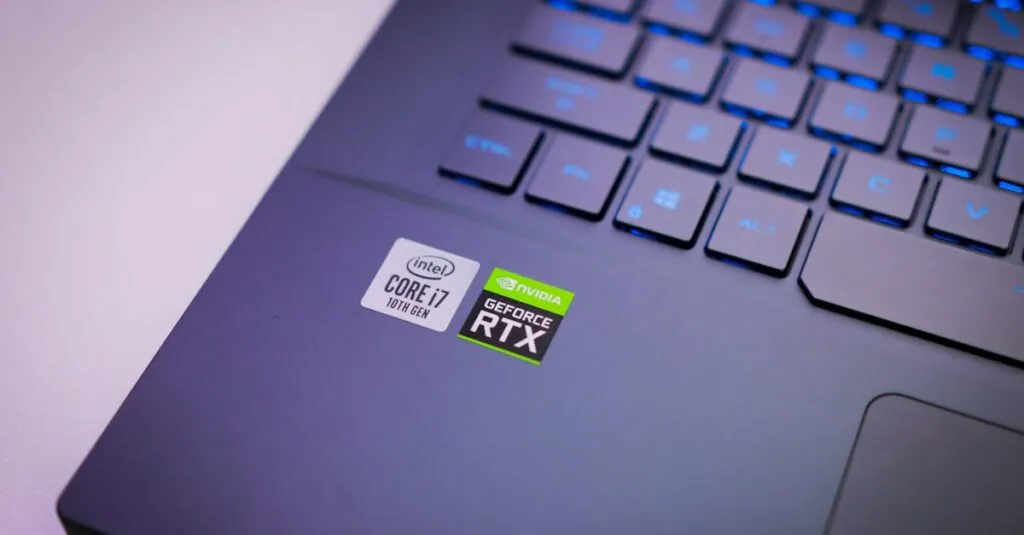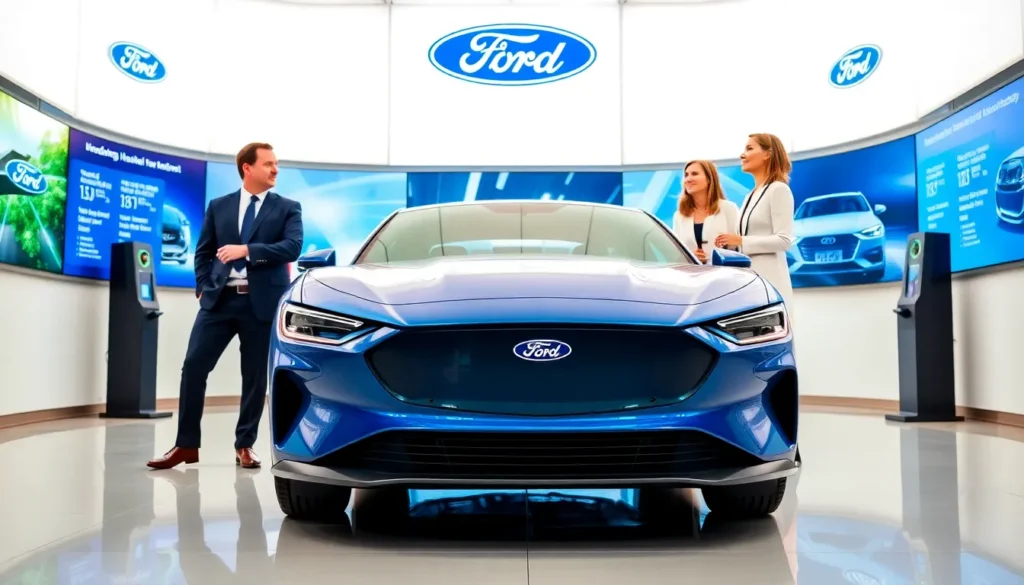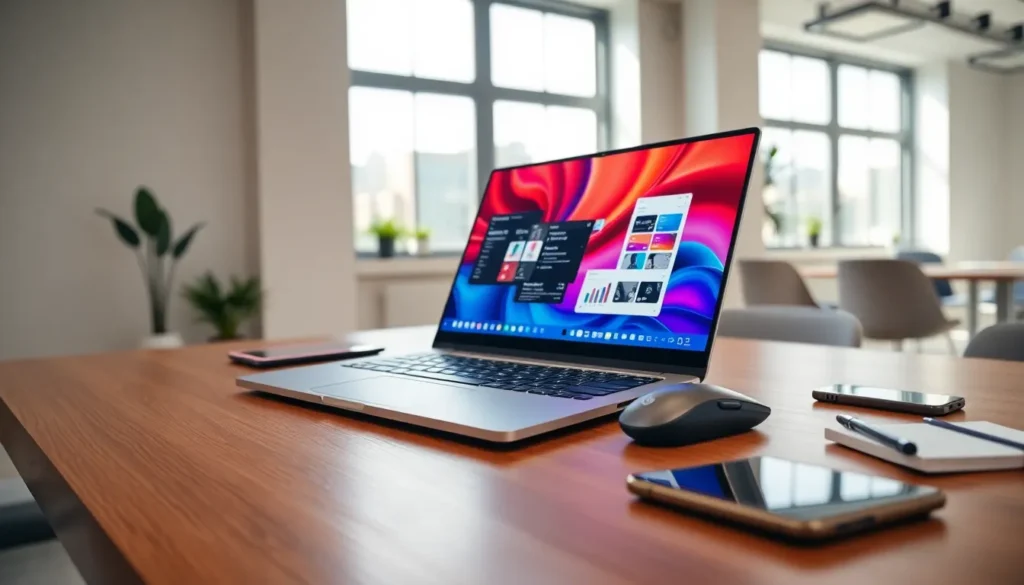Table of Contents
ToggleIn a world where laptops seem to weigh as much as a small child, ultrabooks swoop in like superheroes, saving the day with their sleek design and feather-light frames. These marvels of modern engineering pack powerful performance into a package that’s easy to carry. If you’ve ever wished for a laptop that fits comfortably in your bag without resembling a brick, ultrabooks are about to become your new best friend.
Overview of Ultrabooks
Ultrabooks present a blend of portability and performance in a sleek package. They typically weigh less than 3 pounds, making them easy to carry. Thin profiles, often less than 0.7 inches thick, enhance their transportability. Equipped with fast processors and solid-state drives, ultrabooks handle demanding tasks effectively.
Most ultrabooks feature Intel’s Ultrabook standard. This specification mandates specific performance qualities such as quick boot times and efficient battery life. Battery longevity averages around 8 to 12 hours, catering to users on the go. With high-resolution displays, they provide a vibrant visual experience for tasks like graphic design or content creation.
Connectivity remains crucial for ultrabooks. Many models include multiple USB Type-C and Thunderbolt ports, ensuring compatibility with various peripherals. Most also support Wi-Fi 6, offering faster internet connectivity for seamless online experiences.
Weight and dimension considerations make ultrabooks appealing to travelers and professionals alike. Users appreciate lightweight, durable materials such as aluminum and carbon fiber, which contribute to their modern appearance. Performance remains uncompromised, as ultrabooks integrate powerful graphics options, suitable for casual gaming and multimedia editing.
Overall, ultrabooks have emerged as a versatile option for individuals seeking both functionality and style. These devices cater to a diverse range of users, including students, entrepreneurs, and tech enthusiasts, who prioritize both performance and aesthetics in their computing experience.
Key Features of Ultrabooks
Ultrabooks combine portability and powerful performance in an elegant design, making them attractive for users on the go.
Design and Build Quality
Lightweight materials like aluminum and carbon fiber contribute to ultrabooks’ sleek profiles, typically under 0.7 inches thick. Manufacturers optimize these materials for durability, ensuring resilience during travel. With most models weighing less than 3 pounds, carrying them feels effortless. Their minimalistic designs often appeal to professionals who value aesthetics alongside functionality. Many ultrabooks feature edge-to-edge displays, enhancing screen real estate while maintaining compactness. This design philosophy allows for an impressive balance of form and function.
Performance Specifications
Equipped with fast processors such as Intel Core series, ultrabooks handle demanding applications efficiently. A strong emphasis on solid-state drives (SSDs) ensures quick boot times and rapid data access, often completing tasks faster than traditional hard drives. Many ultrabooks support high RAM capacities, enhancing multitasking capabilities for users. Graphics performance often meets casual gaming and multimedia editing needs, making these devices versatile for various activities. Manufacturers regularly incorporate the latest technology, providing users with a cutting-edge experience.
Battery Life
Typically offering 8 to 12 hours of battery life, ultrabooks are designed for all-day productivity. The integration of energy-efficient components plays a critical role in extending usage time between charges. Users benefit from fast-charging capabilities, allowing them to quickly recharge during breaks. Many models utilize low-power displays, further enhancing battery performance without compromising visual quality. Reports indicate that users find ultrabooks reliable for both work and leisure, reducing the need for frequent charging. This longevity is a significant advantage for those frequently traveling.
Popular Ultrabook Models
Several ultrabook models stand out in the market for their performance and sleek designs. These selections excel in various aspects, catering to diverse user preferences.
Model 1: Features and Review
The Dell XPS 13 remains a top choice among ultrabooks. It features a stunning 13.4-inch InfinityEdge display, providing edge-to-edge visuals. An Intel Core i7 processor powers it, ensuring quick performance for demanding tasks. Battery life reaches up to 12 hours, making it suitable for day-long use. Thin and light at just 2.8 pounds, portability is a major plus for travelers. Connectivity options include Thunderbolt 4, USB Type-C, and a microSD card reader for extended functionality.
Model 2: Features and Review
The MacBook Air with M2 chip is another favorite in the ultrabook category. This model offers a sleek aluminum chassis that enhances durability and aesthetics. Its Retina display boasts a resolution of 2560 x 1664 pixels, delivering vibrant colors and sharp details. Performance stands out with its Apple M2 processor, providing impressive speed and efficiency. Battery life extends to 18 hours, making it perfect for long days. Additionally, it supports seamless connectivity with Wi-Fi 6 capability and two Thunderbolt ports.
Model 3: Features and Review
The HP Spectre x360 14 is renowned for its versatility. Featuring a 13.5-inch AMOLED display, it offers stunning visuals with deep blacks and vivid colors. This model is powered by an Intel Core i7 processor, allowing for smooth multitasking. It weighs only 2.95 pounds, making it easy to carry. Battery life reaches up to 10 hours, accommodating most activities without frequent charging. Numerous connectivity options include USB-C, USB-A, and a headphone jack, ensuring compatibility with various devices.
Pros and Cons of Ultrabooks
Ultrabooks offer a balanced mix of performance and portability. Users appreciate their lightweight design and robust specifications, catering to various needs.
Advantages of Ultrabooks
Portability ranks high among ultrabook benefits. Weighing under 3 pounds, these devices are easy to carry. Fast boot times add to the appeal, with many models powering on in seconds. High-resolution displays enhance visual experiences, perfect for graphics work. Battery life impresses users, averaging 8 to 12 hours, allowing for extended use without needing to recharge. Various connectivity options, such as USB Type-C and Thunderbolt, provide versatility for users. Overall, ultrabooks combine aesthetics with functionality, making them suitable for both professionals and students.
Limitations of Ultrabooks
Cost presents a significant limitation for many ultrabook models. Premium features often lead to higher price points compared to traditional laptops. Limited upgradeability can also discourage some users, as they may find internal components difficult to replace or enhance. Storage capacities may not meet everyone’s needs, especially for power users with large file requirements. Several models sacrifice port options for slimness, potentially requiring adapters for specific peripherals. Lastly, performance for intensive gaming or specialized software might lag behind beefier laptops, making ultrabooks unsuitable for some demanding tasks.
Conclusion
Ultrabooks represent a significant advancement in laptop technology by merging portability with high performance. Their lightweight design and impressive battery life cater to a wide range of users from students to professionals. With features like fast processors and vibrant displays they provide an exceptional computing experience.
While they may come with a higher price tag and certain limitations in upgradeability and storage options ultrabooks remain a top choice for those prioritizing aesthetics and functionality. As technology continues to evolve ultrabooks will likely adapt and expand their capabilities making them a smart investment for anyone seeking a reliable and stylish laptop.




